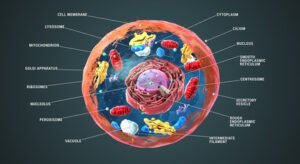The cell nucleus is the largest cellular organelle and the first to be discovered by scien- tists. On average, it accounts for about 10 percent of the total volume of the cell, and it holds a complete set of genes.

The outermost part of this organelle is the nuclear envelope, which is composed of a double-membrane barrier, each membrane of which is made up of a phospholipid bilayer. Between the two membranes is a fluid-filled space called the perinuclear cis- terna. The two layers fuse to form a selectively permeable barrier, but large pores allow relatively free movement of molecules and ions, including large protein mole- cules. Intermediate filaments lining the surface of the nuclear envelope make up the nuclear lamina, which functions in the disassembly and reassembly of the nuclear membrane during mitosis and binds the membrane to the endoplasmic reticulum.

The nucleus also contains nucleoplasm, a clear viscous material that forms the matrix in which the organelles of the nucleus are embedded.
DNA is packaged inside the nucleus in structures called chromatin, or chromatin networks. During cell division, the chromatin contracts, forming chromosomes. Chromosomes contain a DNA molecule encoded with the genetic information needed to direct the cell’s activities. The most prominent subnuclear body is the nucleolus, a small spherical body that stores RNA molecules and produces ribosomes, which are exported to the cytoplasm where they translate messenger RNA (mRNA).




